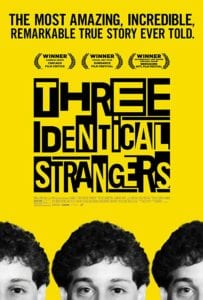Three Identical Strangers, 2018.
Directed by Tim Wardle.
Featuring Edward Galland, David Kellman, Robert Shafran.

SYNOPSIS:
1980, New York. Three teenagers discover they are long-lost triplets who were separated at birth.

A co-production from CNN Films and Channel 4, British filmmaker Tim Wardle’s striking new film, Three Identical Strangers, is something of a contradiction.
The documentary, by its own definition, is a work that sheds factual light on a subject – placing full stops where question marks once were. Three Identical Strangers, however, does rather the opposite: throwing up more open questions than it does conclusive answers. As frustrating as it is fascinating, this is nevertheless the most compelling true story you’ve probably never heard.
Long before the term ‘viral’ had been coined, there was Bobby Shafran.
The year is 1980. A 19-year old is grappling with the familiar concoction of nerves, uncertainty and excitement that befalls all Freshmen on their first day of college. Bringing his beloved, battered Volvo up to the gates of New York’s Sullivan County Community College, Shafran’s aching desire to fit in will have been far from abnormal. It was to be the only part of his day that would be, however.
Pacing the campus pathways, Shafran would quickly realise something wasn’t quite right. At every turn, people were greeting him as though they’d been friends for years. Boys he had never met before were embracing him; and girls were planting affectionate kisses on his cheek. Was he dreaming? Was this an expertly orchestrated prank? Or, did he just have one of those faces?
As it turns out, he did.

Not just a recognisable face, though, but a familiar haircut, smile, body shape, even voice. Something incredible was unfolding. Within a few hours, Bobby was talking on the phone to his doppelgänger – a boy by the name of Eddy Galland – arranging a meet-up. Only this wasn’t simply an uncanny lookalike, it was, in fact, his twin brother – both born 12th July, 1961 – who had been separated at birth. Before his first day of college was out, Bobby was brought face to face with the identical sibling he never knew he had.
But, if the story was already remarkable, it was about to get a sudden thrust into the realms of astonishing.
A third brother, David Kellman, had seen the story in the local paper and quickly made his presence known. Call it fate or sheer luck, but within a matter of days, identical triplets who previously had no knowledge of the others’ existence were now gazing upon one another for the first time in 19 years.

For such an astounding story, it’s strange that, despite premiering at the prestigious Sundance Film Festival earlier this year, Three Identical Strangers appears to have had very little official PR. Instead, it seems to have benefited largely from the word-of-mouth method of marketing. Although, you need only glance fleeting at your Twitter timeline to see why. In a world where the obscure news story is the millennial equivalent of the California Gold Rush, the film’s high-concept premise is an easy sell.
However, Wardle’s film is far from simple. Like the most captivating documentaries, the engrossing power of Three Identical Strangers derives not so much from the story itself, but the ways in which the pieces of this complex puzzle are presented to us.
In its early moments, Wardle sets us firmly on a path of life-affirming familial reconnection and the warming bonds of blossoming brotherhood. It’s an uplifting opening that is as touching as it is timely in its depiction of youthful fame. Almost overnight, Eddy, Bobby and David become the subject of nationwide fascination. Talkshows, interviews, popularity, and even a short cameo in the Madonna-led 1985 film Desperately Seeking Susan quickly follow; before the brothers embark on a shared entrepreneurial venture: a Soho restaurant aptly titled ‘Triplets’. The trio were rapidly making up for lost time, and all seemed well.

However, such swift elation was short-lived. With all the ingredients of a classic Fairy-tale, it is perhaps unsurprising that several shady characters and sinister secrets eventually rear their ugly heads. That same joyous narrative path we were so deliberately led down soon takes a sharp, dark, disturbing turn. As such, Three Identical Strangers becomes a tale about so much more than it appears, with details that earlier seemed harmless returning with a poignant sting.
Knowing less is certainly more here, so unveiling such revelations would undoubtedly dilute the impact of the many twists Wardle cleverly weaves throughout his intricately constructed retelling. But this is impressive work that transcends the conventional documentary format; boldly transitioning from the calm shallows of the extraordinary to the vast, unsettling depths of ethics, morality, psychology, and the age-old question of nature vs. nurture.
Ultimately, it might prod and provoke more than it proves; but Three Identical Strangers is no less powerful for it. The term ‘Flabbergasted’ seems to have unjustifiably gone out of fashion. If there was ever something to bring it back, this is it.
Flickering Myth Rating – Film:★ ★ ★ ★ / Movie: ★ ★ ★ ★
George Nash










